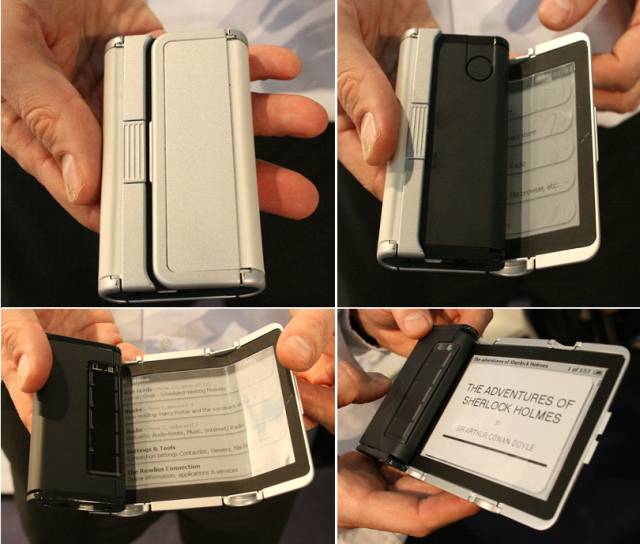The Amazon Kindle and the Apple iPad have proven there's consumer demand for tablets and e-readers. The trick now is to master the technology behind their displays. E-ink like that used in the Kindle requires very little power but features no color or video abilities. The opposite goes for LCD screens like the iPad's. Can the two be combined to form both sharper views and better efficiency?As director of marketing for the Qualcomm (Nasdaq: QCOM) division that manufactures the Mirasol display technology, Cheryl Goodman is racking up the frequent flyer miles, thanks to the boom in the e-reader/tablet computer market. She's the one who educates journalists and analysts about Mirasol's promise of color e-reader screens, along with lower power consumption, better viewing in sunlight and a smaller environmental footprint.
During the latter part of 2009, however, she noticed that her audience had grown to include information technology specialists for publishers. Goodman certainly expected to be making plenty of trips to original equipment manufacturers' headquarters, but she never guessed that she would be spending most of her time in New York, visiting with media giants who want to know exactly how their newspaper, magazine, book and video content will look on a Mirasol device.
"Publishers are trying to find their digital road map and figure out their content in the new form factors," Goodman told TechNewsWorld. "Publishers are doing their best in creating compelling content, but when it comes to finding out how to engage with the hardware and what companies are creating, the consumer experience, they're absolutely trying to get up to speed as soon as possible."
Now Goodman has an additional title -- director of publisher relations -- and it's evidence that there's a white-hot spotlight shining on her part of the tech industry. Amazon's (Nasdaq: AMZN) Kindle set off a stampede in the e-ink reader category. The Kindle can last for weeks on a single charge, but that's because its monochromactic e-ink display demands less power. The success of Apple's (Nasdaq: AAPL) iPad has opened up the world of colorful books, magazines/newspapers and video for media consumption, but the battery life slips down to 10 hours of viewing.
Qualcomm's Mirasol e-readers -- due out in the fall -- use microelectromechanical (MEMS) systems to harness natural nearby light that's reflected back out of the screen. It cuts down on the need for power-sapping backlighting.
Mirasol's Origins, Competition
The current buzz for Qualcomm's technology has its roots in 2005, when the San Diego-based company acquired Iridigm Technology. The company immediately set to work on bringing a product to market that would allow for color content and video viewing in a portable device.
"It's not easy stuff" to develop, Goodman said. "You can take LCD technology and modify it. Everything so far has been some evolution of LCD. Instead of evolving that whole process, we've revolutionized a new way to display, using what nature is giving us."
The result has been lots of discussion with potential partners interested in Qualcomm's promise that it can triple the battery life found on current iPads. "If you can do that in an e-ink world, if you can give that power savings and have the color and video experience, well who wouldn't want that?"
Some 50 companies are either already battling or getting ready to fight for market share in the e-reader segment, Goodman estimates. Pixel Qi and E Ink Corporation are preparing products that they say will also allow for color screens without requiring two or more batteries.
Qualcomm is also deep into development for Mirasol-based screens for smartphones, and the success of the iPad may require another business model adjustment -- one that allows for tablet computers, Goodman said. "Apple has validated the form factor. They've made something very cool that people may want to add to their suite of devices. We'll have to watch that space too."
The Future of Display
The Society for Information Display's annual symposium in Seattle in late May provided a showcase for what the industry can expect in terms of evolutionary -- and revolutionary -- products over the next few years. The thrust of the promise continues to focus on active matrix OLED, especially with smartphone screens, Munisamy Anandan, SID president, told TechNewsWorld.
"A lot of the color you see on those screens is beautiful," Anandan said. "The angle of view is also wide -- almost 130 degrees and goes to 160 degrees with no problem. "
Color and white-light-emitting diodes are also developing at a very high rate, he said. "You saw efficiencies go up in the past year or so. We now have 150 lumens per watt, and people are galloping toward 200 lumens. It's going to reduce the power level of LCDs -- that means less backlight power consumption. They have four LEDs in the average cell phone, but now people tend to do three LEDs, and then the cost comes down. With the efficiencies, if the power is low, the cost is low."
The SID symposium also featured Sony's (NYSE: SNE) flexible OLED screen that could be spooled around a pencil, unrolled to show video, and then rolled back up again to carry in a shirt pocket.
During the latter part of 2009, however, she noticed that her audience had grown to include information technology specialists for publishers. Goodman certainly expected to be making plenty of trips to original equipment manufacturers' headquarters, but she never guessed that she would be spending most of her time in New York, visiting with media giants who want to know exactly how their newspaper, magazine, book and video content will look on a Mirasol device.
"Publishers are trying to find their digital road map and figure out their content in the new form factors," Goodman told TechNewsWorld. "Publishers are doing their best in creating compelling content, but when it comes to finding out how to engage with the hardware and what companies are creating, the consumer experience, they're absolutely trying to get up to speed as soon as possible."
Now Goodman has an additional title -- director of publisher relations -- and it's evidence that there's a white-hot spotlight shining on her part of the tech industry. Amazon's (Nasdaq: AMZN) Kindle set off a stampede in the e-ink reader category. The Kindle can last for weeks on a single charge, but that's because its monochromactic e-ink display demands less power. The success of Apple's (Nasdaq: AAPL) iPad has opened up the world of colorful books, magazines/newspapers and video for media consumption, but the battery life slips down to 10 hours of viewing.
Qualcomm's Mirasol e-readers -- due out in the fall -- use microelectromechanical (MEMS) systems to harness natural nearby light that's reflected back out of the screen. It cuts down on the need for power-sapping backlighting.
Mirasol's Origins, Competition
The current buzz for Qualcomm's technology has its roots in 2005, when the San Diego-based company acquired Iridigm Technology. The company immediately set to work on bringing a product to market that would allow for color content and video viewing in a portable device.
"It's not easy stuff" to develop, Goodman said. "You can take LCD technology and modify it. Everything so far has been some evolution of LCD. Instead of evolving that whole process, we've revolutionized a new way to display, using what nature is giving us."
The result has been lots of discussion with potential partners interested in Qualcomm's promise that it can triple the battery life found on current iPads. "If you can do that in an e-ink world, if you can give that power savings and have the color and video experience, well who wouldn't want that?"
Some 50 companies are either already battling or getting ready to fight for market share in the e-reader segment, Goodman estimates. Pixel Qi and E Ink Corporation are preparing products that they say will also allow for color screens without requiring two or more batteries.
Qualcomm is also deep into development for Mirasol-based screens for smartphones, and the success of the iPad may require another business model adjustment -- one that allows for tablet computers, Goodman said. "Apple has validated the form factor. They've made something very cool that people may want to add to their suite of devices. We'll have to watch that space too."
The Future of Display
The Society for Information Display's annual symposium in Seattle in late May provided a showcase for what the industry can expect in terms of evolutionary -- and revolutionary -- products over the next few years. The thrust of the promise continues to focus on active matrix OLED, especially with smartphone screens, Munisamy Anandan, SID president, told TechNewsWorld.
"A lot of the color you see on those screens is beautiful," Anandan said. "The angle of view is also wide -- almost 130 degrees and goes to 160 degrees with no problem. "
Color and white-light-emitting diodes are also developing at a very high rate, he said. "You saw efficiencies go up in the past year or so. We now have 150 lumens per watt, and people are galloping toward 200 lumens. It's going to reduce the power level of LCDs -- that means less backlight power consumption. They have four LEDs in the average cell phone, but now people tend to do three LEDs, and then the cost comes down. With the efficiencies, if the power is low, the cost is low."
The SID symposium also featured Sony's (NYSE: SNE) flexible OLED screen that could be spooled around a pencil, unrolled to show video, and then rolled back up again to carry in a shirt pocket.






